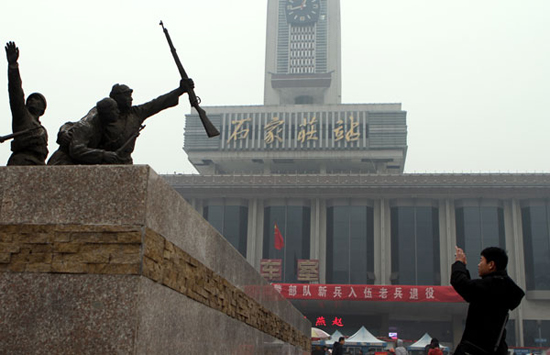
 |
| A visitor takes a photo of a sculpture that stands in front of the city's old railway station. (Photo Provided to China Daily) |
Resource imbalance
The relationship is not without friction, though. While Shijiazhuang and other cities in Hebei understand the strategic importance of supporting the capital, by providing water and energy for example, there have been complaints that Beijing is draining the pool of local talent and other resources.
"In the early stage of regional cooperation, there exists an imbalance in the flow of resources, not just in this area, but also in the Yangtze River Delta and other areas. It's a phenomenon that's also been seen in other countries and is a general trend during development," said Xing Tianhe, deputy chief planner at Hebei's department of housing and urban-rural development.
The cities in these economic clusters need to pursue different routes of development, utilizing a variety of resources to avoid unnecessary competition, said Xing, who noted that the financial gap separating Shanghai, and the cities of Hangzhou and Nanjing is not as wide as that separating Beijing, Tianjin and Shijiazhuang.
"Shijiazhuang should take advantage of the shared resources, but it must pursue its own path and then it will be able catch up with the two municipalities," said Xing.
Throughout the development period, the railway acted as a lifeline and in several transport hubs, the main rail routes pass through the downtown areas. In Shijiazhuang, large open markets have grown around the railway station, raising the numbers of local passengers, especially during rush hours.
The city government has ploughed money into the transport infrastructure, building overpasses and bridges to connect districts separated by the rail line.
"The cities where expansion was fueled by the railway share similar space restrictions on urban planning," said Xing. His preferred solution is the one adopted by Shijiazhuang; relocating the railway stations away from the downtown areas.
Although the railways brought modern industries to the new cities, they also brought pollution.
Initially the pollution was caused by the railway, especially during the era of steam engines, in the form of noise, waste water, litter and smoke. It became a huge problem for cities on the major routes.
In addition, the industries were highly polluting. In Shijiazhuang, iron, steel and textiles were the pillars of the local economy for many years.
In the past five years, the local government has produced a raft of policies that will optimize the industry structure while protecting the environment at the same time.
"The heavy smog that covered the city for months was not directly connected with the railway, but the city's economy expanded through industries drawn by and related to the railway," said Liang Yong, vice-president of the Hebei Institute of Tourism Planning and Development. He pointed out that the city of Tangshan, which was spurred by the development of the railway, has a serious environmental problem. "These cities were all influenced by the railway to a certain degree."


















 College student car models show youthful vigor
College student car models show youthful vigor


![]()
